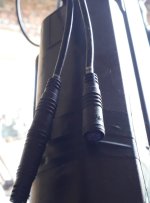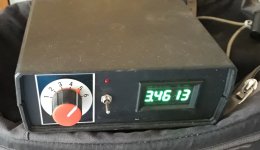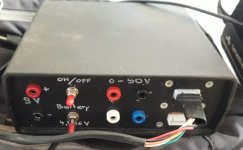You are using an out of date browser. It may not display this or other websites correctly.
You should upgrade or use an alternative browser.
You should upgrade or use an alternative browser.
How to determine the current required to balance battery pack?
- Thread starter evbkezzz
- Start date
All balance current is is the amount of current the balancer can bypass on full cells, while still allowing that same current to flow into non-full cells.
So the "right amount" is determined by how quickly you want balancing to finish.
Which itself is determined by how poor quality or poorly matched (or how aged) your cells are, because good quality well-matched cells will stay in balance. The worse the cells are, the more mismatched they are, the less it takes to get them out of balance.
So the "right amount" is determined by how quickly you want balancing to finish.
Which itself is determined by how poor quality or poorly matched (or how aged) your cells are, because good quality well-matched cells will stay in balance. The worse the cells are, the more mismatched they are, the less it takes to get them out of balance.
flippy
1 MW
- Joined
- Aug 12, 2015
- Messages
- 2,351
any pack you can put on a bike or scooter can be balanced with the regular 100mA you find in most BMS.
once you go bigger then a couple of Kwh you need to look at a more robust solution.
i assume you are going to use new or matched cells. with unmatched junk you need serious balancing hardware.
once you go bigger then a couple of Kwh you need to look at a more robust solution.
i assume you are going to use new or matched cells. with unmatched junk you need serious balancing hardware.
amberwolf said:All balance current is is the amount of current the balancer can bypass on full cells, while still allowing that same current to flow into non-full cells.
So the "right amount" is determined by how quickly you want balancing to finish.
Which itself is determined by how poor quality or poorly matched (or how aged) your cells are, because good quality well-matched cells will stay in balance. The worse the cells are, the more mismatched they are, the less it takes to get them out of balance.
Thanks! While I understand what balancing is and how it works, I find it difficult to figure out a balance current for my pack. I will be using new cells from either LG, Samsung, Sony or Panasonic. How much can the cells go out of balance, if they are used with a proper BMS?
I am planning to balance the cells only during charging. I will be charging at 0.5C. Can I complete charging+balancing in just under 2-2.5 hours?
flippy said:any pack you can put on a bike or scooter can be balanced with the regular 100mA you find in most BMS.
once you go bigger then a couple of Kwh you need to look at a more robust solution.
i assume you are going to use new or matched cells. with unmatched junk you need serious balancing hardware.
Thanks.
I will be using a 3P6S pack with new cells. I building a BMS myself and the hardware I use allows me to use 5mA per cell without the need of using external FETs. I am wondering if it will be sufficient.
flippy
1 MW
- Joined
- Aug 12, 2015
- Messages
- 2,351
docware said:If you use new, appropriate original cells from Big Four, actual need for balancing current is zero. Assuming you are not abusing them (high discharge current, high DOD, …..).
So the need is not zero.
flippy
1 MW
- Joined
- Aug 12, 2015
- Messages
- 2,351
evbkezzz said:Would a 5mA balance current be sufficient?
depends. it might be when its new but once it wears it can be very difficult to keep it even with that low current.
for average sized packs like the ones used in bikes the standard number is 100mA.
flippy said:docware said:If you use new, appropriate original cells from Big Four, actual need for balancing current is zero. Assuming you are not abusing them (high discharge current, high DOD, …..).
So the need is not zero.
I have strong notion that balancing of the cell groups is often overemphasized regarding the lifetime of the battery pack. Yet there are factors like DOD, charge rate, discharge rate, SOC, optimal temperature, etc, which are most significant for Li-ion cell degradation. Effort to save the battery pack after abusing the pack by running it high DOD, charge rate, discharge rate, …., seems to me somewhat – ineffective.
I am not saying that BMS is needless, I am saying that we should concentrate on the beforementioned factors and optimize battery pack to the optimal parameters if lifetime of the battery pack is our priority. No SMART BMS can improve battery pack lifetime abused by high DOD, discharge rate,…..
If we run the original brand-name cells in the optimal parameters window, balancing by BMS is secondary, or needles.
I first met questioning the BMS role in November 2017 at the Shawn McCarty video :
https://www.youtube.com/watch?v=pljSZcEwc8Q
That awaked my curiosity what is going on in my 10s5p Sanyo GA battery. Ended by wiring each cell group with help of 2pcs of HIGO-B6-B external cables .

After some time found out that Junsi CellLog8 and iSTD Battery Checker BC- 8s are showing different values. In the effort to determine real true values I build single purpose equipment. In fact it is battery powered simple voltmeter with 0,1 mV resolution and a rotary switch and possibility to connect external voltmeter. By the way, Junsi CellLog 8 itself can have inaccuracy up to 10 mV.


In the equipment is built-in also precise voltage reference MAX6341 (4,096 V ±0.02%) at the rotary switch position No 6.
The main advantage is differential measuring of the cell groups by one voltmeter and sufficient resolution 0,1 mV.

From the very beginning of the measurement in May 2018, the cell groups were usually in the range 3 mV. At the same time I started to charge to cca 4 – 4,1 V max, so that the battery BMS didn´t enter into balancing mode probably more than 14 months now, at least.
Need to say that DOD, charge rate, discharge rate, SOC, … are very friendly for this 10s5p Sanyo GA battery.
Here are measuring results from 2019 :

Such stable equal voltage is reason for my doubt of BMS balancing importance.
flippy
1 MW
- Joined
- Aug 12, 2015
- Messages
- 2,351
please dont advertise this single case as the rule. its not, especially not when using the full SoC and more serious loads like most people do.docware said:Such stable equal voltage is reason for my doubt of BMS balancing importance.
Just another opinion :
Grin technologies - „good quality cells rarely drift out of balance in a series string, and can easily handle 100 or more cycles and maintain a perfect voltage matching even if the BMS circuit doesn’t do any active balancing“
https://www.ebikes.ca/tools/charge-simulator.html
If cells need balancing doesn´t it mean that it´s little bit late ? Doesn´t it mean that cells health is affected enough to see the result ? What is reason for the cells disbalancing ?
None balancing can return back the degradation of the cell : SEI growth, SEI decomposition, binder decomposition, lithium plating, dendrite formation, loss of active anode material, loss of active cathode material, electrode particle cracking, graphite exfoliation, etc, etc.
Isn´t time to disrupt our rigid thinking and to start questioning the balancing dogma ?
Grin technologies - „good quality cells rarely drift out of balance in a series string, and can easily handle 100 or more cycles and maintain a perfect voltage matching even if the BMS circuit doesn’t do any active balancing“
https://www.ebikes.ca/tools/charge-simulator.html
If cells need balancing doesn´t it mean that it´s little bit late ? Doesn´t it mean that cells health is affected enough to see the result ? What is reason for the cells disbalancing ?
None balancing can return back the degradation of the cell : SEI growth, SEI decomposition, binder decomposition, lithium plating, dendrite formation, loss of active anode material, loss of active cathode material, electrode particle cracking, graphite exfoliation, etc, etc.
Isn´t time to disrupt our rigid thinking and to start questioning the balancing dogma ?
flippy
1 MW
- Joined
- Aug 12, 2015
- Messages
- 2,351
flat tire said:I prefer occasional manual inspection and if necessary rebalancing. BMS is just something else that can go strand you or make your battery catch fire. Yes with smart use good cells well specced go out of balance extremely slowly.
its always handy to have the right type of connectors to bypass the bms if needed or just a simple high current switch.
single bullet connectors are quite handy for this.
999zip999
100 TW
I would need a bms on the loaner bike and a set of sense wires for checking and balancing if needed.I have had a signalab bms kill a parallel set of cells. Over drain when resting.
Similar threads
- Replies
- 5
- Views
- 281
- Replies
- 3
- Views
- 715
- Replies
- 0
- Views
- 131

